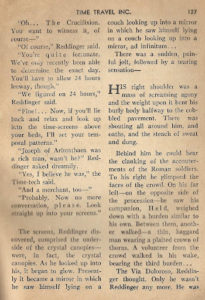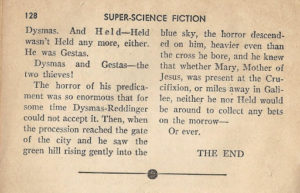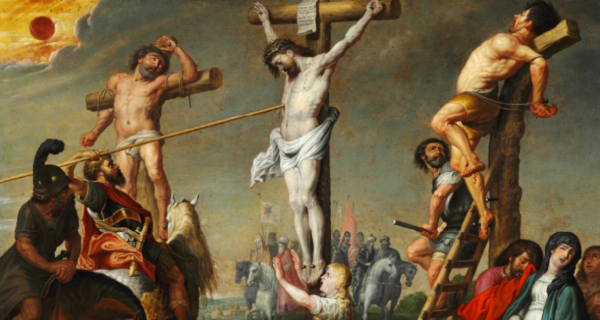One of the best ways to visit the reality of biblical truth is through biblical fiction. To take the reality of the historicity of the bible and add wonderous speculation about how events turned out beyond the written word, but in the spirit and context of the story recorded by the authors. St.’s Mathew, Mark, Luke and John did not pen down every aspect of the story and has given room for thought about how certain details may have worked out. Biblical fiction is Biblical commentary in the form of a story as opposed to a written dry, static lecture.
One of the most popular biblical fiction books of all time was written by Catholic novelist Louis DeWohl in his book called ‘The Spear’ (1955) about Gaius Cassius Longinus, the Roman centurion who hurled his spear into Christ on the Cross.
And now he knew that he must make sure, absolutely sure that the man was dead. He beckoned to the soldier to whom he had spoken. The fellow came, reluctantly.
“Give me your spear,” Cassius said roughly.
The man obeyed. His hands were trembling. No use letting him try; he’d only botch it. It was a regulation six-foot spear, the blade almost two inches wide and near the shaft a little over half an inch thick.
Cassius weighed it in his hands to get the feel of it and then tightened his grip. Raising the spear with both hands, he thrust it with all his strength forward and up, through the crucified man’s heart.
For one split moment he thought that he had been hit by a bolt of lightning. Everything around him lightened up with terrifying clarity, and he saw the long, lean body, pale and golden, with its arms outstretched as if to embrace him, and his spear entering it. He heard the thud, and he felt the resistance, either of the body or of the wood of the cross behind it.
Then it was night again, a dark-red night splashing all over him and blinding him completely, and he staggered and would have fallen if he had not held on to the spear in the crucified man’s heart.
Blood. He was full of blood. The whole world was full of blood. He was suffocating in it.
From far, far, away came the sound of crying. The world was crying.
He wiped the blood from his face.
It was still day. The sun had broken through the clouds just as he had thrust in the spear, and for one moment he had seen clearly, for that one moment. Then darkness again… It had not been lightning but the sun.
The long, lean body hung before him, pale and golden, with its arms outstretched, as if to embrace him. The head with the crown of thorns had sunk on the chest.
But realistic biblical fiction isn’t the only way to tell Jesus’s story. Fantasy and Science Fiction can serve as an allegorical device to drive home a biblical truth more deeply than just an ordinary story. One of the best theological books I have ever read was a children’s book called ‘The Proud Tree’ (1981) by Luane Roche. I used to read it to my CCD kids when I taught catechism. It tells the story of the crucifixion from the viewpoint of Rex, the tree that became the cross Jesus carried to Calvary. This is the part I am talking about when I think of deep theology put simply for children (and adults to read).
As if in answer to his wondering, Rex heard Jesus speak. What he said sent shivers up and down Rex’s trunk.
“Father, forgive them. They do not know what they are doing.” Jesus’ voice was gentle and pleading. Rex was stunned!
“Don’t know what they’re doing? Forgive them? Are you going mad with Your pain? Nobody forgives people like this. Even trees don’t forgive such terrible cruelty. All creation knows we have to hate our enemies! Especially when they beat us and put us to death.”
Rex kept trying to reason with Jesus. After all, the Man on the Cross had every reason in the world to be angry.
“Listen, nobody ever forgives people like this,” he said again.
“Nobody, of course, except maybe G-O-D!” Suddenly Rex realized who this Man was. He began to feel weak. Rex began to stammer.
“Who-who did He call Father? I have heard talk of a Father in heaven-and a Son. Could this really be God? Can it be that this is Truly the Father’s Son?”
The very thought filled Rex with wonder.
“He-He’s touching me. He carried me. He is nailed to me. Why would God want to be so close to Me?”
What if you could go back in time and see Jesus in person as he gave himself up on Calvary? In Sci-Fi author Garry Kilworth’s first short story ‘Let’s Go to Golgotha!’ (1974), he explores this idea. In this story, time travel is a reality and people can go on vacations to the past. Some Time-travelling tourists decide to go on a “Crucifixion Tour”. The tour operator warns the tourists that they must not do anything to disrupt history: specifically, when the crowd is asked whether to spare Jesus or Barabbas, the tourists must all join the call “Give us Barabbas!” (a priest absolves them from any guilt for so doing).
You know what happened and how it happened. We will arrive on the day that Pilate asks the inhabitants of Jerusalem whom he should set free, as the citizens are permitted to grant amnesty to one prisoner over the Feast of the Passover. When the crowd begins to shout ‘Barabbas’, as we know it must, then you must shout it too. You must not appear to be different in any way from the rest of the citizens. This is vitally important. You have to appear to be in agreement with the rest of the crowd. You must jeer at Christ and shake your fists as he drags the cross through the streets. You must remember that communities in those times were not very large, and if a small section of people is silent the others will begin to wonder why and will question you. You will be sure to give yourselves away under stress — not because you are idiots but because you are clever. People in those times were simple. They followed the ring-leaders, and they will regard anyone who does not with great suspicion. It is far more difficult to think and speak with simplicity under pressure than it is the reverse, so do as I say and everyone will be perfectly safe. It may be distasteful and even repugnant to your nature, but it is a necessity. When they nail up the sign ‘Jesus of Nazareth, King of the Jews’, you must laugh. Those that remain awestruck while the rest of the crowd are dancing and prancing, screaming and shouting, will only draw attention to themselves by their silence. I repeat, it is for your own safety.
*SPOILER ALERT: Don’t Read the Next Paragraph If You Don’t want to Spoil the Story.*
When the moment comes, the protagonist suddenly realizes that the crowd condemning Jesus to the cross is composed entirely of tourists from the future, and that no actual Jewish Jerusalemites of 33 AD are present at all. This gives new meaning to the song, “Were You There When They Crucified My Lord. And it is also a point that makes anti-semites look rather foolish, when theologically it is all our sins that crucified Christ. This story brings that point home very strongly.
Look at the crowd! Look around you! There are no Jews here. No natives. The only ones here are us. The holiday-makers. Do you realize the enormity of what we’ve done? The whole guilt of mankind rests on our shoulders.”
This story is collected in the book ‘The Songbirds of Pain.’
The last story I want to mention is a very rare hard to find story called Time Travel Inc. by Robert F. Young found in Super-Science Fiction (February 1958). I managed to find a copy on eBay. The story is out of print and out of copyright I assume.
In this tale, two men find a way to travel back in time through a company called Time Travel Inc. You can read the whole story linked above for the little details of how time travel works in that story, but to sum it up shortly, their mind can transfer to a body that is similar to who they are now. And they end up being significant characters in the crucifixions story.


May we always keep in mind our pride and sins when we think of the Lord dying for us, and our presence at Calvary.
Fiction and Science Fiction can help us to imagine us being there as they Crucified Our Lord.

